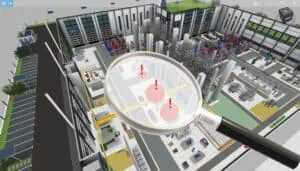Maximize Efficiency and Productivity

When it comes to planning a new plant or factory layout, there are many things to consider creating an efficient and effective design. The type of manufacturing process, the machinery and equipment required, the flow of production, and the overall operation of the plant all need to be taken into account. With so many elements to pay attention to, it’s no wonder that plant layout and design is often seen as a daunting task. However, with careful planning and execution, it is possible to create a well-designed and efficient manufacturing plant that can support a successful business.
The Benefits of an Efficient Plant Layout
Planning and designing a plant layout is an important step in the manufacturing process. It can have a significant impact on efficiency, machinery, and flow. Industrial Engineering professionals are experts in plant design and can help planters design a layout that is best suited to their needs. A well-designed plant can help improve production and operation management.
Factors to Consider When Designing a Plant Layout
Reorganizing the layout of a factory plays an integral role in production. By reforming and restructuring, it is possible to optimize efficiency, cut costs and facilitate communication. There are many different configurations that can be adopted; one popular approach is setting up stations along a definite path – referred to as ‘production line’ design. Alternatively, workstations may follow the order of manufacturing processes, which is known as ‘process arrangement’. If you haven’t fully analyzed your type of production, start with our blog post Job shop production vs. production line?
Types of Plant Layouts
When it comes to plant layout and design, there are a few different types that you can choose from. The type of layout or design that you choose will depend on the type of manufacturing process that you are using, as well as the kind of equipment and machinery that you have in your factory. Here are a few of the most common types of plant layout and design:
1. Process-oriented layout: This type of layout is designed around the manufacturing process. The goal is to create a smooth and efficient flow of production so that each operation can be carried out in the most efficient way possible.
2. Equipment-oriented layout: This type of layout is designed around the machinery and equipment in the factory. The goal is to create a flow that is efficient and makes best use of the available space and resources. Sankey-diagrams will help you, to make the flow more tangible.
3. people-oriented layout: This type of layout is designed around the people who will be working in the factory. The goal is to create a comfortable and safe working environment, with easy access to all the necessary equipment and resources. Cardboard engineering is a typical method to adress these issues.
4. product-oriented layout: This type of layout is designed around the products that will be produced in the factory. The goal is to create a flow that is efficient and makes best use of the available space and resources. You can switch over to our blogpost, in case you want to get a deeper understanding about What is a production cell?
5. hybrid layout: This type of layout combines elements from two or more of the above types of layouts. The goal is to create a layout that is custom-tailored to the specific needs of the manufacturing process. Creating an ideal-layout is your first step for designing these types of manufacturing.
Strategies for Optimizing Your Plant Layout
When it comes to running a successful manufacturing process, having an efficient plant layout is essential. An effective facility ensures that all parts of the production process are connected, equipment and machinery are adequately spaced, and the flow of materials is efficient. Industrial Engineering and Plant Design play a key role in mapping out the placement of equipment and machinery in a facility. Here are some tips for creating an effective plant layout:
1. Include Your Operations Management Team – It’s important to involve your operations management team when creating a plant layout. They understand the operational needs and have a deeper understanding of how all the processes interact with each other. Having them involved will ensure that all aspects are considered before making any final decisions. If you want to know more on the importance, you may read through our blogpost Teamwork in shopfloor layout planning.
2. Analyze Workflow – Every production process has its own workflow, and it’s important to analyze this before designing a layout. This will help you determine where to place different pieces of equipment and machinery so that everything flows efficiently within the facility. Learn more about how to analyze the flow: Material flow planning to optimize logistics, production, and storage
3. Allow Room For Growth – When designing your manufacturing layout, be sure to keep in mind future growth. The last thing you want is to be stuck with a design that can’t accommodate additional equipment or personnel if need be. Any manager would no doubt agree that optimized space utilization in production and logistics areas is a key goal of factory planning.
4. Keep Safety In Mind – The safety of workers should always be top priority, as well as adhering to local regulations regarding safety standards in industrial spaces. Make sure pathways are wide enough for workers to move around safely, adequate lighting is installed throughout the facility, and emergency exits are clearly marked at all times. Floormarkings are an important topic: How important are floor markings in industry settings?
Conclusion
A well-designed layout for a plant can mean the difference between success and failure. By taking the time to design a custom layout, manufacturers can improve communication, efficiency and decrease costs.
No problem, simply subscribe to our Blog-News!



